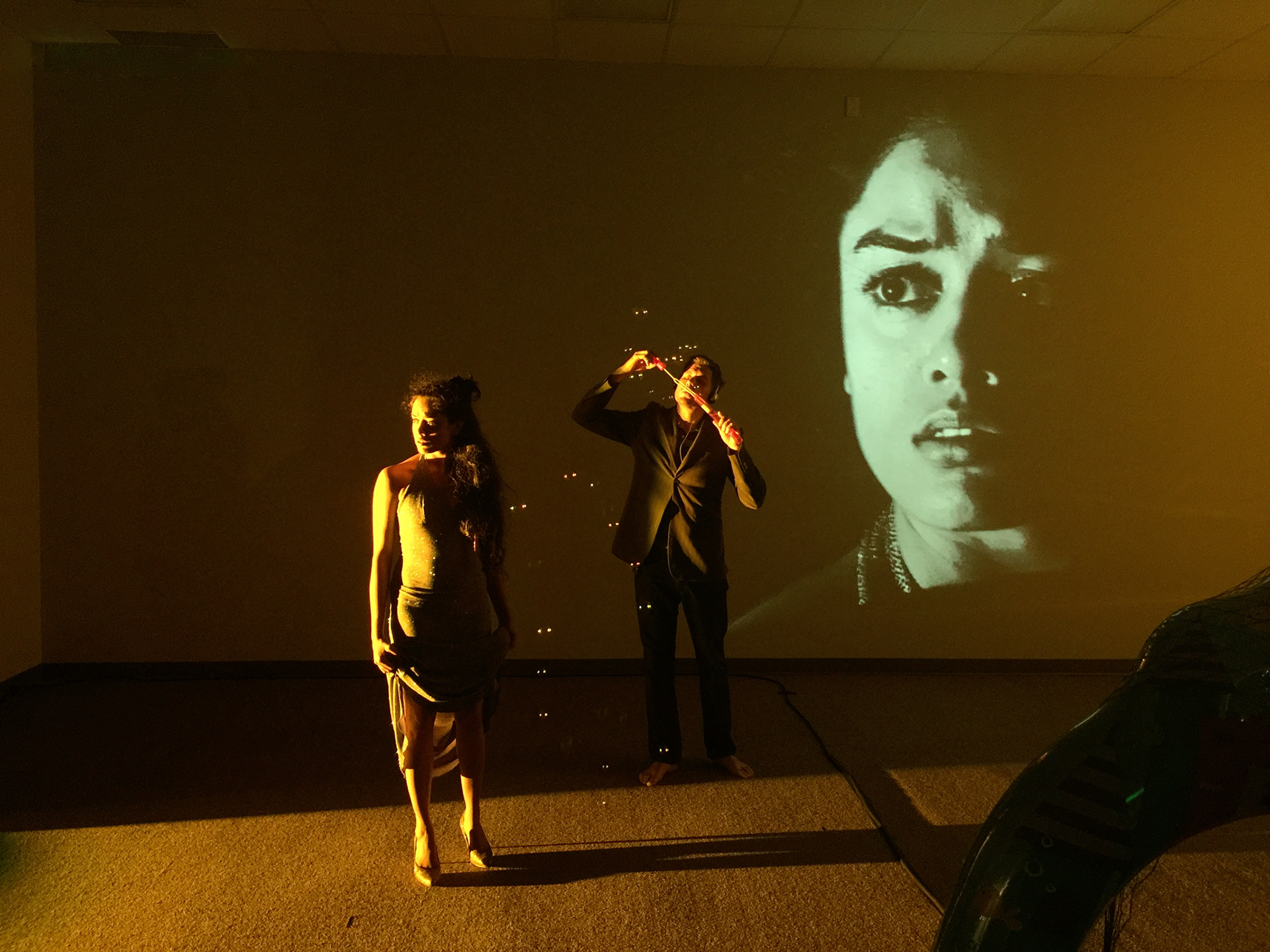
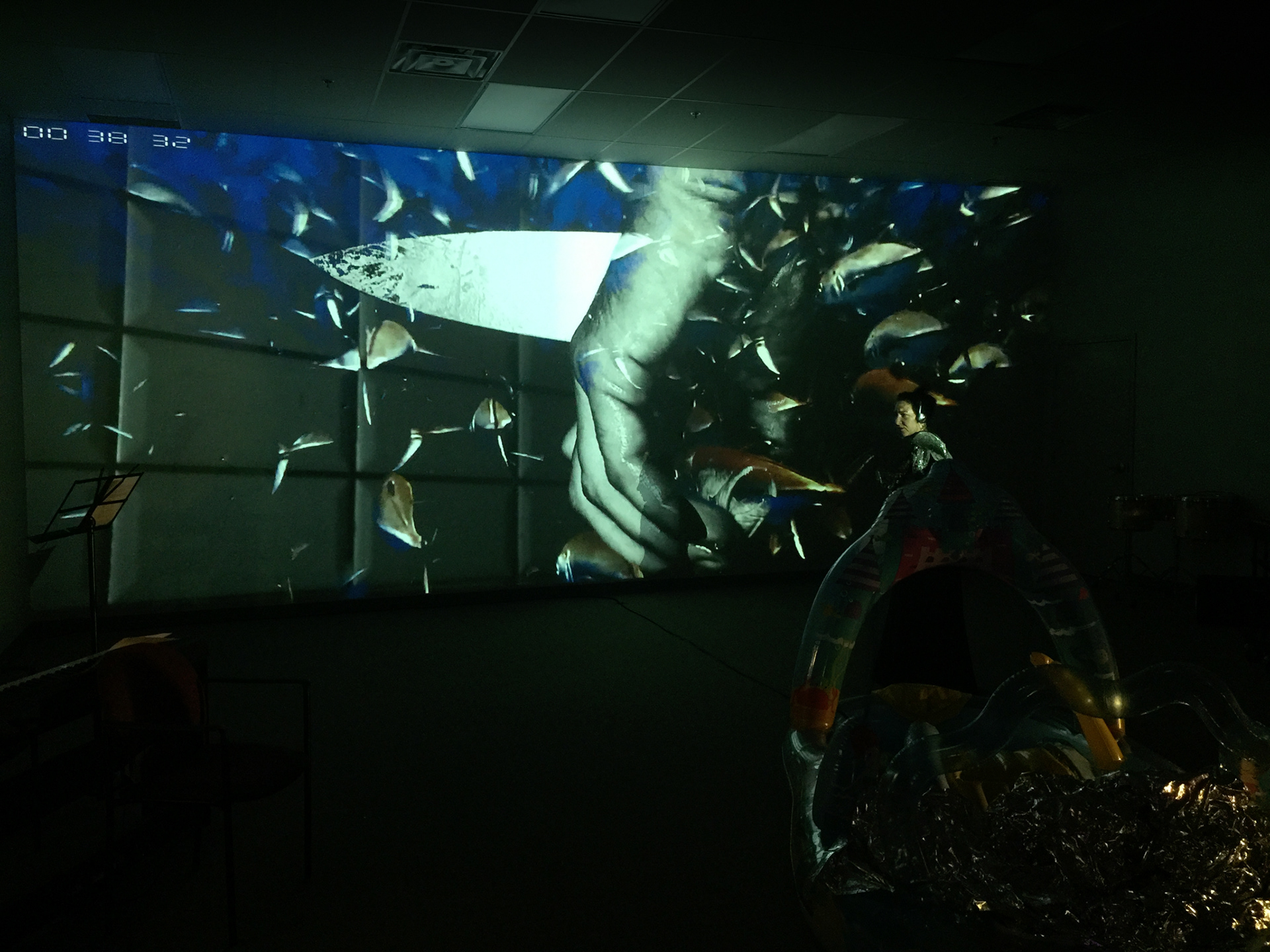


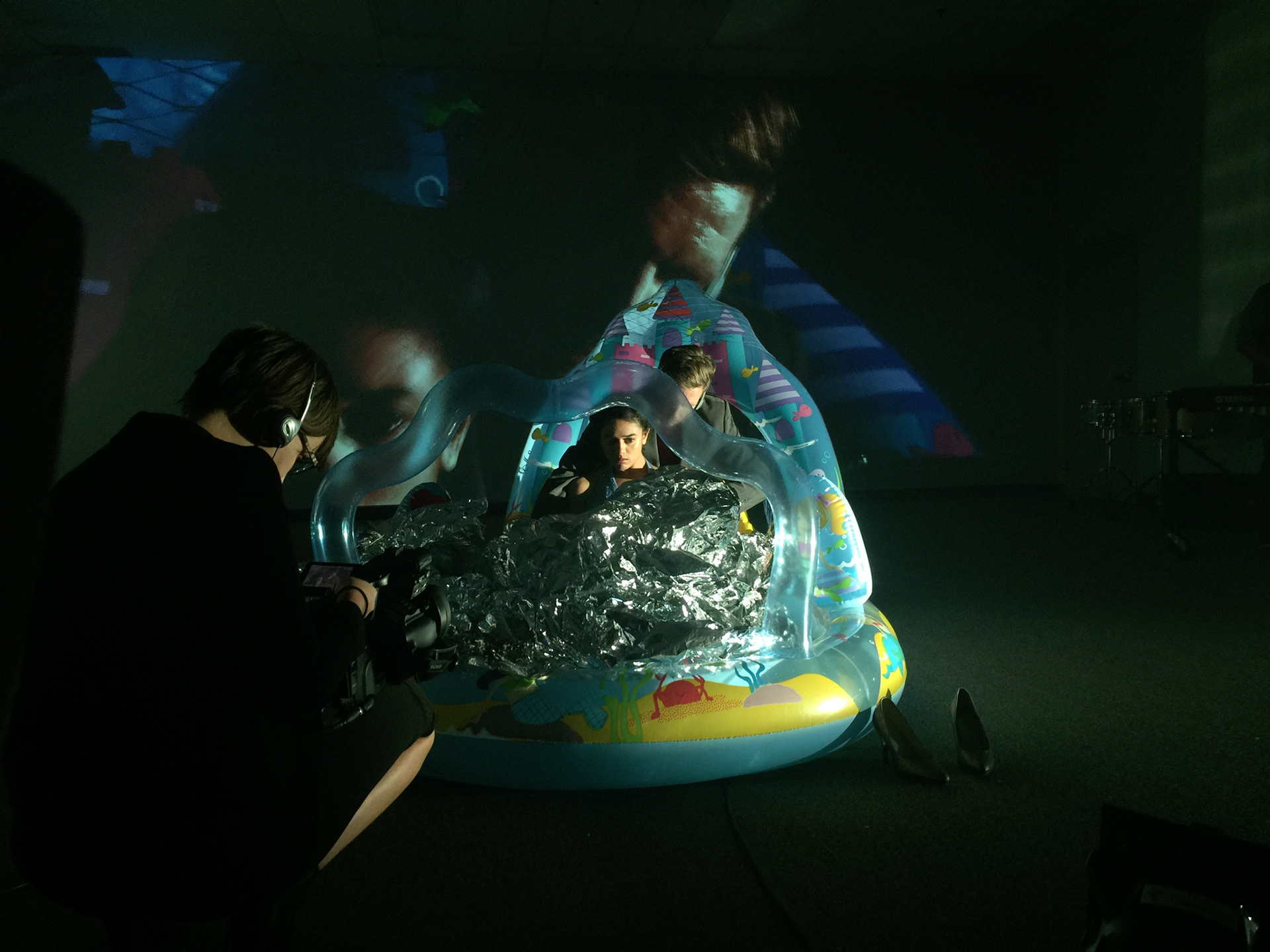
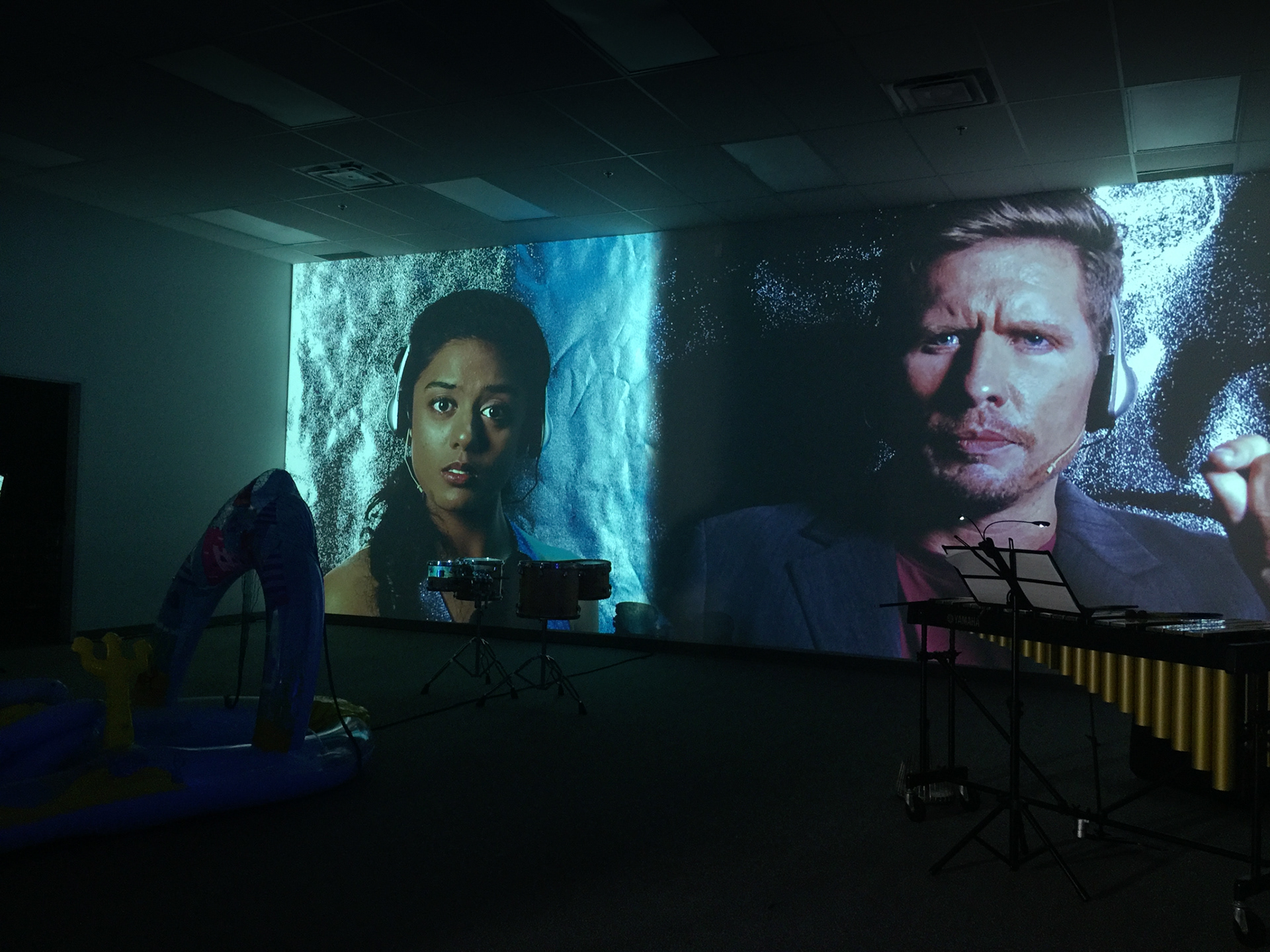
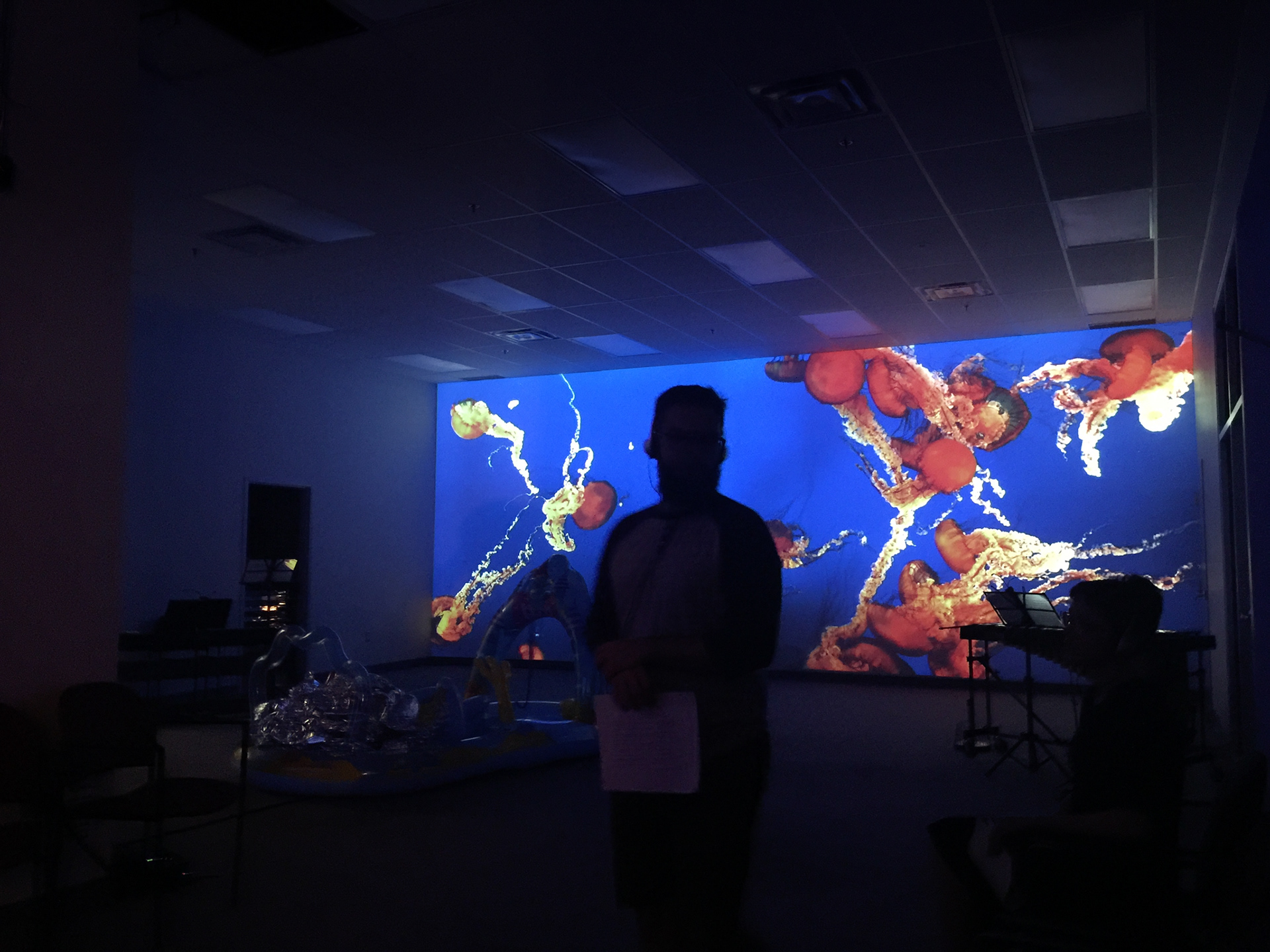
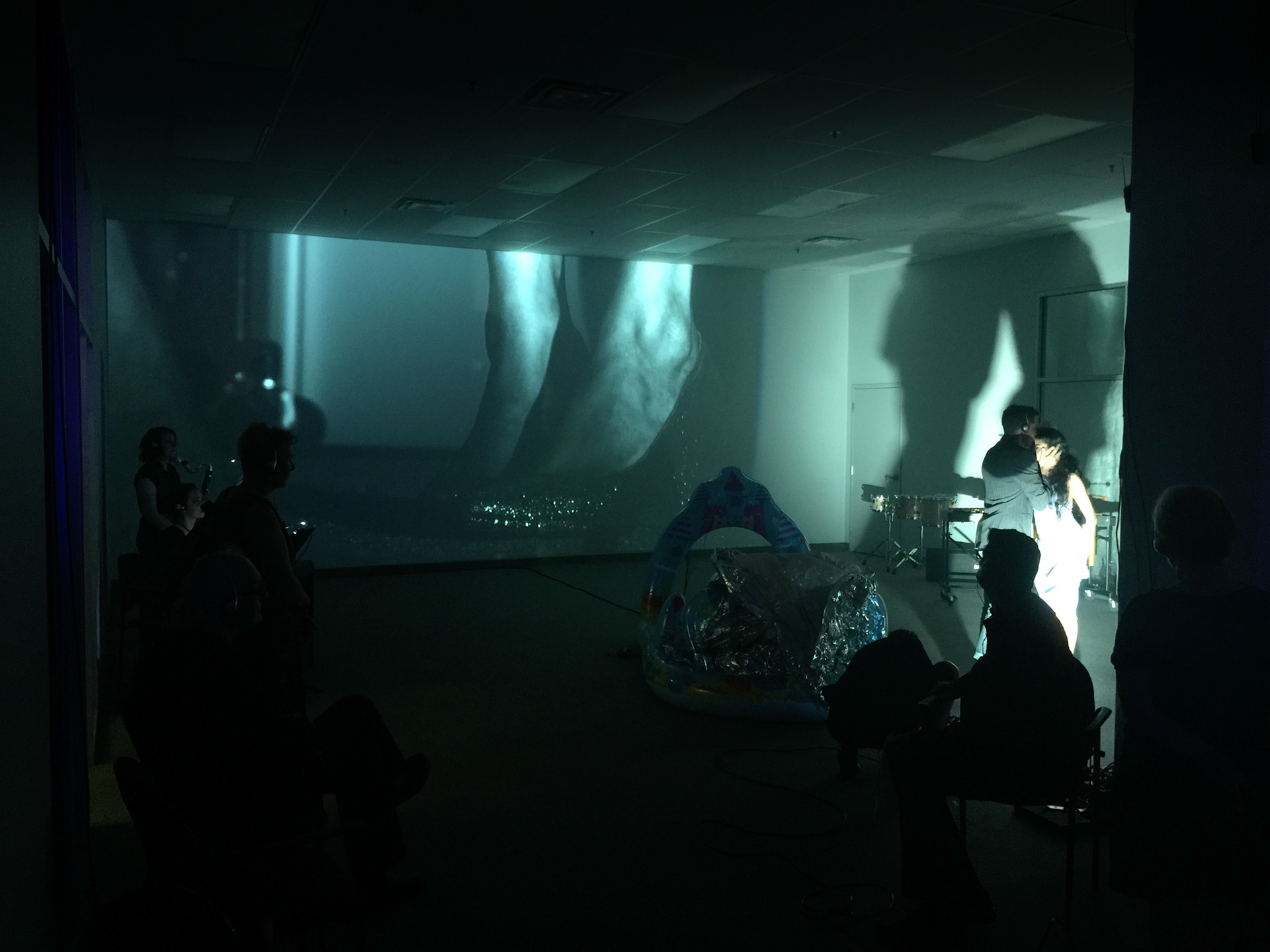
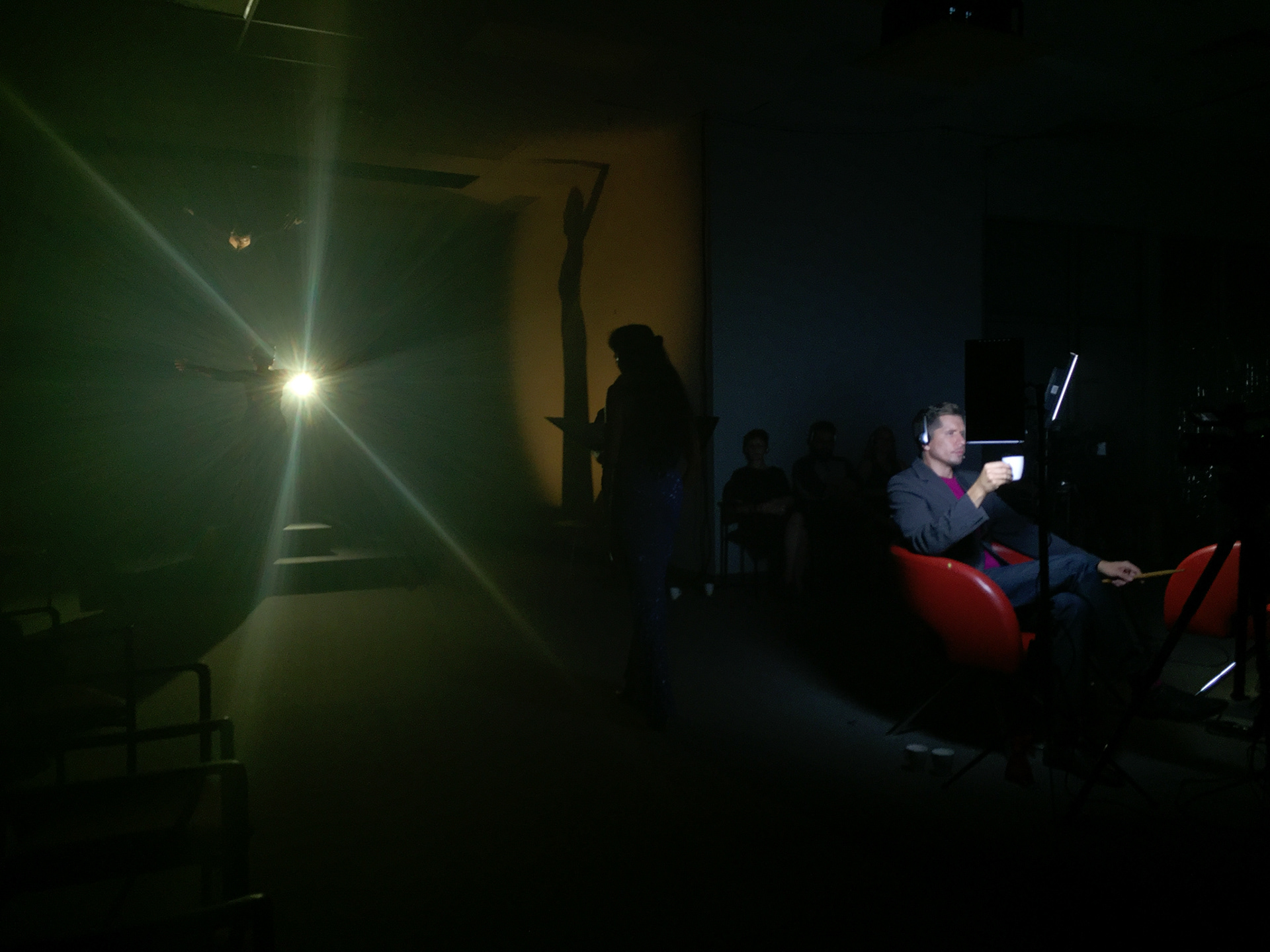
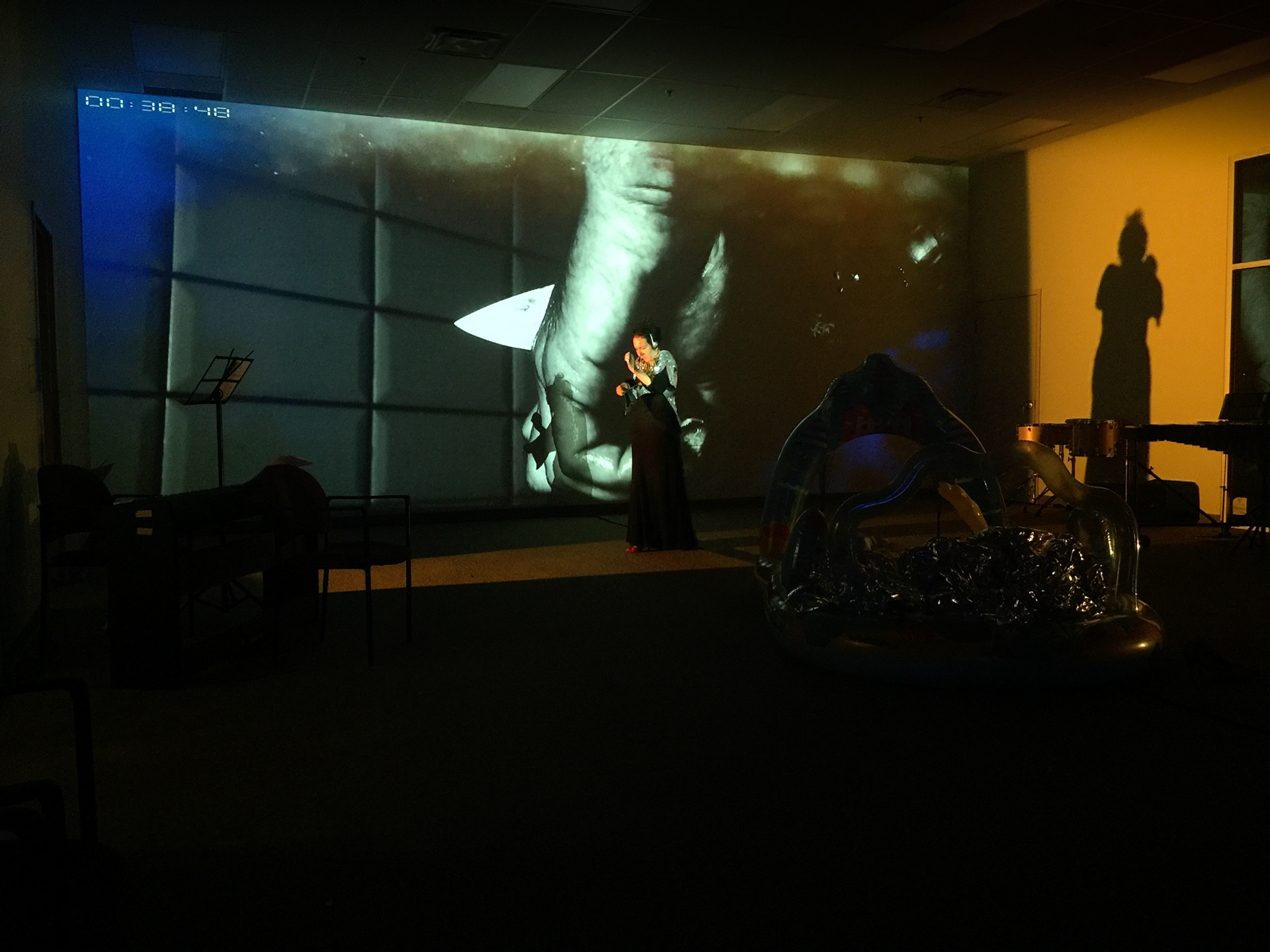
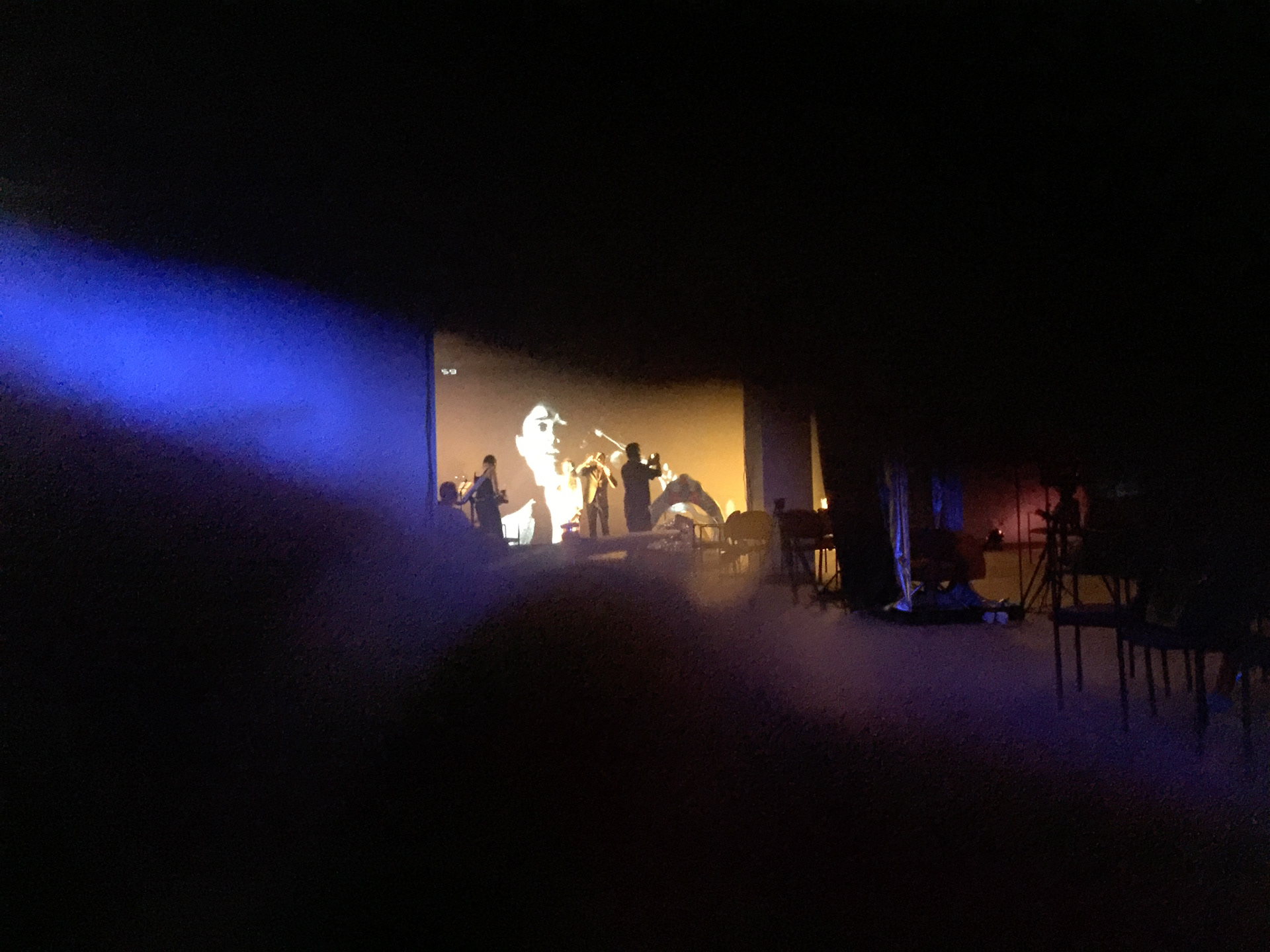

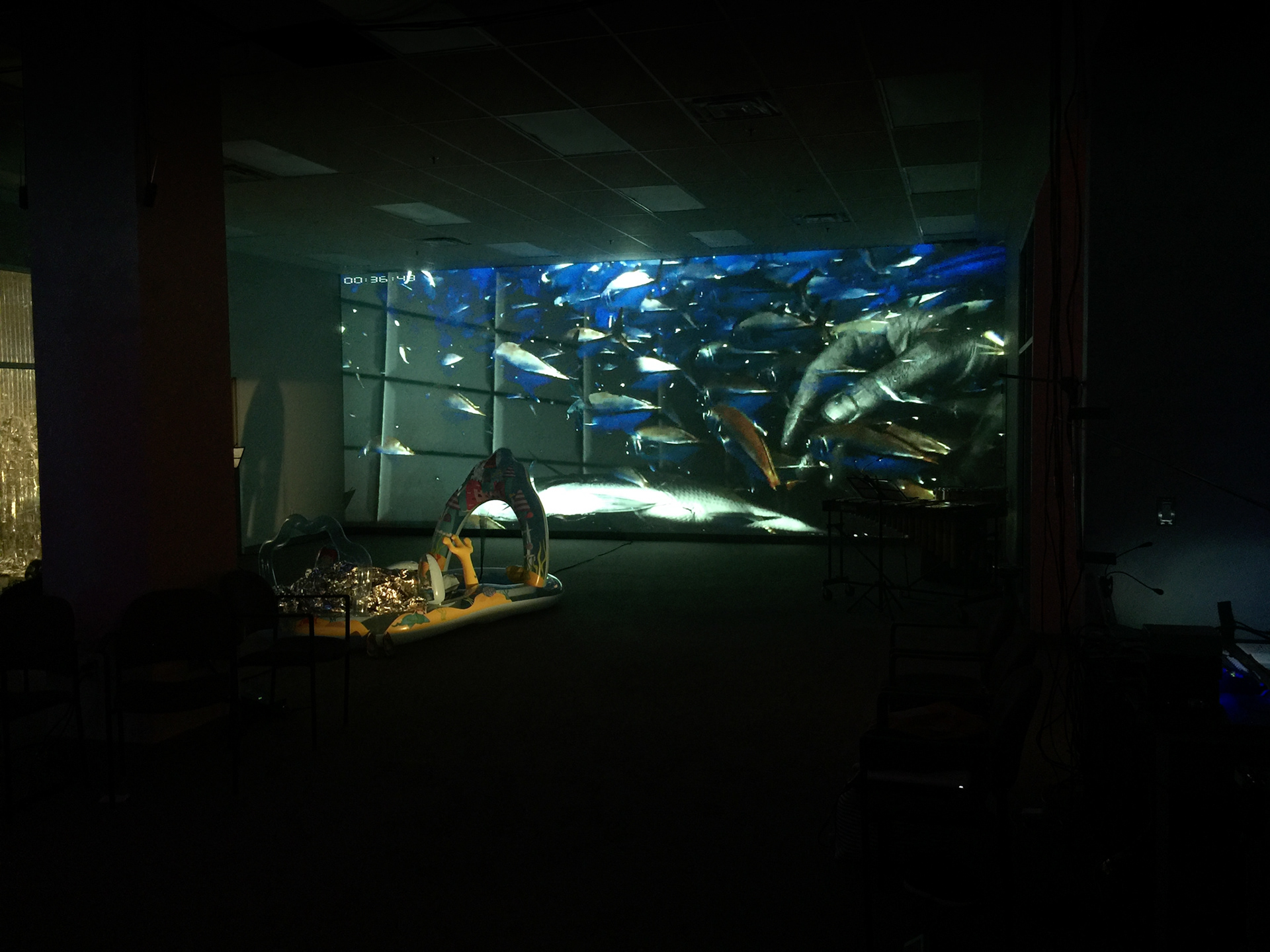
Impact Theatre Festival 2017, Kitchener, Ontario, Canada
Text by: Adam Cowart
Music/Sound by: Peter Hatch, Andrew O’Connor, Colin Labadie
Physics by: Lin-Qing Chen, Aida Ahmadzadegan
Paul Cegys: Space (Scenography, Video Design, Dramaturg)
Kaylee Lock-O'Connor: Space (Video and Promotional Design)
Chelsea Vanoverbeke: Space (Scenogrphy)
Peter Hatch: Time (Music/Sound)
Andrew O’Connor: Time (Sound/FM Broadcast Design)
Colin Labadie: Time (Sound)
Andy Houston: Continuum (Director, Dramaturg)
Music/Sound by: Peter Hatch, Andrew O’Connor, Colin Labadie
Physics by: Lin-Qing Chen, Aida Ahmadzadegan
Paul Cegys: Space (Scenography, Video Design, Dramaturg)
Kaylee Lock-O'Connor: Space (Video and Promotional Design)
Chelsea Vanoverbeke: Space (Scenogrphy)
Peter Hatch: Time (Music/Sound)
Andrew O’Connor: Time (Sound/FM Broadcast Design)
Colin Labadie: Time (Sound)
Andy Houston: Continuum (Director, Dramaturg)
Performed by:
Pam Patel - mezzo-soprano/actor
Bó Bardos - mezzo-soprano/actor
Dan Morphy - percussion/actor
Richard Burrows - percussion/actor
Kathryn Ladano - bass clarinet/actor
Aida Ahmadzadegan – physics lecture
Pam Patel - mezzo-soprano/actor
Bó Bardos - mezzo-soprano/actor
Dan Morphy - percussion/actor
Richard Burrows - percussion/actor
Kathryn Ladano - bass clarinet/actor
Aida Ahmadzadegan – physics lecture
Entanglement is an immersive and intermedial performance that attempts to generate conversation and understanding about how the very contemporary phenomenon of algorithmic programming is having a profound effect on our society, and how this phenomenon can be seen to have deep, historical patterns in human behaviour and cultures.
According to the Oxford English Dictionary, to be entangled is to be “twisted together with or caught in” something, causing “difficulties or complicated circumstances from which it is difficult to escape”. In quantum physics entanglement refers to the “extremely strong correlation that exists between quantum particles — so strong, in fact, that two or more quantum particles can be inextricably linked in perfect unison, even if separated by great distances.” (Institute for Quantum Computing website.) Einstein called this “spooky action at a distance” - he couldn’t accept this characteristic of quantum mechanics (recently proven in experiments.)
The intersection of these concepts provide the central focus for our project, which has to do with the paradox of our social worlds becoming increasingly distant emotionally and psychically, problematizing the physical intimacy we still share. A central theme of the work is the human/social ramifications of algorithmic methods increasingly being integrated into our working and personal lives: from stock market high frequency trading to Amazon purchases, and from Netflix film and television viewing to Lavalife dating. Under the logic of neo-liberal society, we’ve become familiar with the idea that algorithmically driven machines are replacing physical labour, but we have not yet come to grips with how algorithms are starting to replace intellectual, social, and even emotional labour.
An algorithm is defined as “a process or set of rules to be followed in calculations or other problem solving operations, especially by a computer.” (OED) This definition begs numerous questions, especially when applied to societal concerns; for example, who invents the rules? Who invents the criteria for how rules are decided upon? How are these sets of rules ‘followed’? How are these processes affected by the fact they are solved/operated by computers?
A central theme in this project is that we are being subsumed in an (corporate driven) algorithm that doesn’t serve our needs; our economic system, modes of exchange and communication, etc. all support a value system that serves capitalism more than the needs of most human beings. Algorithms allow for a ‘top-down’ approach to both analysis and implementation – an approach that can create powerful tools for attending to a huge array of problems and scenarios. These tools have provided means to track and predict the spread of epidemic diseases; they are also used to track general trends in musical tastes both individually and across various populations. Unfortunately, these same tools are also used in increasingly more autocratic ways and funnel the resources of many for the benefit of a few. Our project explores both the promise/beauty of our thought technologies and the reasons how/why we fail ourselves by using these same technologies to limit ourselves and create problems.
In the past two decades, the Waterloo Region has become known as Canada’s “Silicon Valley of the North” or as the cities of Kitchener, Waterloo, and Cambridge are sometimes called: “Canada’s Technology Triangle”. In our region there are over 12,000 businesses devoted to the tech. sector, including internationally known companies such as Christie, Blackberry, ComDev, and OpenText. In many ways this industry is the new industrial culture in our region, and so as artists, we aim to create work that will engage in meaningful dialogue with this emerging culture. Entanglement is an attempt to generate conversation and understanding about how the very contemporary, hi-tech phenomenon of algorithmic programming has deep, historical patterns in human behaviour and cultures. Our project brings together emerging artists in our region with mid-career artists who work across the country and internationally; it places artists in creative dialogue with workers in an industry that is transforming the industrial and cultural landscape of this region and the world.
Neil Postman, in his 1985 book Amusing Ourselves to Death, writes: “To be unaware that technology comes equipped with a program for social change, to maintain that technology is neutral, to make the assumption that technology is always a friend to culture is, at this late hour, stupidity plain and simple. […] Introduce the alphabet to a culture and you change its cognitive habits, its social relations, its notions of community, history and religion. Introduce the printing press with movable type, and you do the same. Introduce speed-of-light transmission of images and you make a cultural revolution. Without a vote. Without polemics. Without guerrilla resistance. Here is ideology, pure if not serene. Here is ideology without words, and all the more powerful for their absence. All that is required to make it stick is a population that devoutly believes in the inevitability of progress.”
The growing technological sophistication and ubiquity of handheld devices such as the iPhone are altering the way a majority in our society define themselves, communicate, see and interact with the world – perhaps on a scale and with the same impact that the birth of photography or the invention of perspective drawing did, in previous eras. Neil Postman claims that these technological shifts in seeing, representing and interacting with the world are ideological; Entanglement examines the place where the technological meets with the ideological, and how this examination illuminates a reconsideration of how algorithms, at the core of technological development, are ideological constructs.
Form, Content, and Process
Entanglement brings together the interests and working processes of artists Peter Hatch, Andy Houston and Paul Cegys. The creative process we are employing is truly interdisciplinary, lacking both traditional roles (composer, director, designer) and a hierarchical system of organization. Our goal is not just to create great theatre and music, but to bring authentic voices from other sectors: our scriptwriter, Adam Cowart, is a full time employee of President’s Choice “Joe Fresh” brand and brings first hand experience of the corporate/business world; our physicist, Lin-Qing Chen, is a PhD at Waterloo’s Perimeter Institute for Theoretical Physics, specializing in one of its most adventurous branches, quantum gravity.
Similar to our fragmented existence, elements of physics, music and theatre co-mingle and intersect in often interesting and unusual ways. Our project explores both the commonalities between these worlds and the frictions between them. Theoretical physics demonstrates paradoxical truths about the world, proven by mathematics: particles that spookily affect one another when they seemingly shouldn’t be able to, realities defined by probabilities rather than certainties, the possibility of multiple space/time dimensions. It is these discoveries about our physical world, and the algorithms that describe them, that help to create new technologies that increasingly integrate with our human existence. Art gives us ways to also consider the paradoxes in which we live. Unfettered by the need to prove things by math, artists pose speculative questions and perspectives about our existence; theoretical physics provides an array of lenses and orientations through which artistic practices may work, and thereby better apprehend the workings of digital code.
The basic structure of our performance is a theoretical physics lecture that sets off a series of other events, following an algorithmic model. The events that emerge from the lecture, then, make up multiple complimentary threads: musical ideas, narrative, physical scores, digital scenography, and acoustic mapping. Extended musical sections allow time for reflection on narrative, physical, and digital elements, and these help create a context for audience immersion. The physics lecture reflects themes of the work in an authentic technical language of math, physics, and information theory.
Music and Sound
In Entanglement, music and sound are intertwined throughout the work and produced by a live ensemble as well as pre-composed and randomly generated sound files. Musicians double as actors in the work, sometimes blending these identities, and sometimes not. Simple number sequences ("One, One, two, One, two, three" shouted by men, and "Two, three, two, three, five" sung lyrically by women) comprise the text for some sections; these simple algorithms outline durational portions of the music played. These sequences are the basis for much of the movement of the work as well for the visual imagery. More complex algorithms are composed using Max/Msp software and realized in both human and computer performance. The use of weighted probability is a key compositional concept throughout the work and mirrored by the use of structured improvisation both during, and separately from, composed sections in the performance. (In both cases, sets of instructions allow for random elements controlled by given parameters.)
A major, innovative exploration of the piece has to do with audio spatiality. The audience is all fitted with identical ‘open’ headphones, which allowed for both hearing acoustic sound and material introduced through a local FM broadcast. This material, which ranged from music to simultaneous translation to whispering, provided an interesting ‘three-dimensional’ audio involvement for the audience, supporting a highly ‘entangled’, immersive experience of the performance. New sound/music scores are being developed to exploit this entangled listening experience, and material from last year was revisited and revised for this new approach. We have recently begun discussions with a local startup company, WeMesh, about using their technology in our piece - it allows for real-time synchronicity amongst smartphones, not hindered by the usual latency issues.
Devised Theatre
This approach to theatre creation is particularly good for challenging conventional ways of understanding how theatre may best represent our world. Devised theatre is generated from a variety of resources, from the body, a particular place, or an object, to various media modes: music, video, film, or all of the various platforms for expression on-line. Often this freeing up of the creative process allows for a variety of other elements of performance to be questioned, evaluated, or re-examined. For example, notions of how identity, language, the body, place, or media are represented in performance are often key subjects of examination in devised theatre. In our intermedia work, devised theatre practices are combined with structured musical improvisation, video scenography, and on-line modes of expression – all methods bring together pre-composed elements with intuitive, improvisational input, and are focused on algorithmic subject material through the concept of weighted probability. In this process, where random elements are combined with a set of constrained possibilities (much like a multiple choice test, where free choices are made from a limited set of choices), we are able to create an interactive framework of creation with all collaborators (including the audience). Most of these collaborators are musicians of a high calibre, some with substantial theatre training, some with none. Developing the work through devised theatre methods combined with structured musical improvisation (as well as composed elements and computer-generated musical elements) provides a rich tapestry with which to work, while simulating the balance between structured frameworks and indeterminate forces generated in algorithmic applications.
History
In August of 2014, with modest public funding (a $3000 grant provided by the Region of Waterloo Arts Fund), money from our own pockets, and the immense good will of our performers, we ran an eight-day workshop where we did a preliminary exploration of themes and forms of presentation for this project. The result of this workshop process was a performance entitled Algorithmyth.
In August 2015, we had a second workshop, with funds provided by the Ontario Arts Council Multi and Integrated Arts program. Similar to the first workshop, this workshop took place at the Institute for Quantum Computing, Mike & Ophelia Lazaridis Quantum-Nano Centre, University of Waterloo, and the result was a second performance, entitled Algorithmyth: entangled.